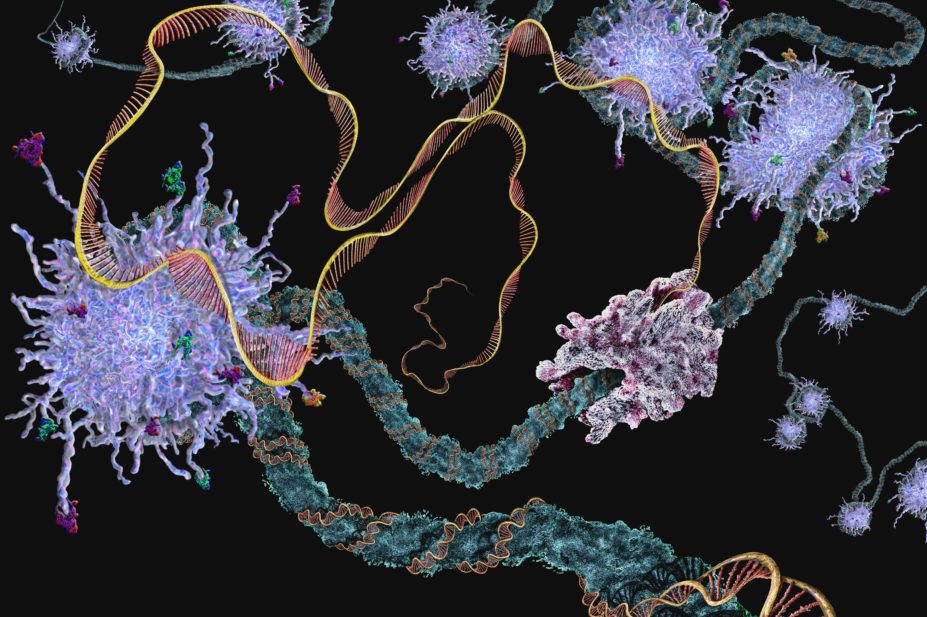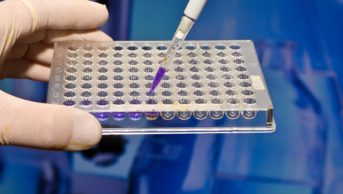
Science Photo Library
Those who have studied pharmacology will have learned the properties and actions of the many medical drugs at our disposal in healthcare. But, in practice, not every patient will respond to the same drug in the same way. Across individuals, the efficacy and safety of drugs we prescribe varies widely[1]
.
Pharmacogenetics looks at this variation, which is down to gene variations that affect individual drug responses. Often these variations will lie across a person’s genome, in genes encoding drug absorption, distribution, metabolism and excretion, or in those encoding drug targets. And, in some cases, they may occur in genes with an unknown function[1]
.
These ‘pharmacogenetic’ or ‘pharmacogenomic’ markers can be used to determine which drugs may or may not work for a patient, and the US Food and Drug Administration now lists marker information relating to around 200 drugs[2]
. Using genomic markers is also becoming an important part of the healthcare agenda in the UK, with the NHS aiming to integrate genomic medicines into its routine care by 2025[3]
.
However, the genetic variations indicated by these biomarkers account for only a subset of the patient-specific factors that influence these varied drug responses. We often consider our bodies as the manifestation of nature (genes) and nurture (our environment) — but there is a third, less well-known factor at play with these interindividual differences.
These epigenetic modifications can influence an individual’s response to particular drugs
Influences on gene expression
This third factor is ‘epigenetics’: the idea that our environments and lifestyles can affect the way our genetic codes are expressed. Epigenetic modifications do not change the DNA sequence itself; instead they modulate the accessibility of the DNA and the chromatin structure (the packaged DNA), which leads to alterations in gene expression. Poor diet, obesity, low physical activity, smoking, alcohol, pollution and stress could all influence these modifications[4]
.
Epigenetic modifications include:
- DNA methylation (where methyl groups attach to the DNA sequence, with DNA promoter methylation, generally leading to silencing);
- Modifications of the histones (which give structure to the packed DNA, and influence gene expression);
- Changes to higher order chromatin structure (the way in which DNA is packed, which can influence DNA accessibility and therefore gene expression);
- MicroRNAs (short non-coding elements that can affect gene expression)[4],[5]
.
Importantly, these epigenetic modifications can also influence an individual’s response to particular drugs[6]
. The role of epigenetic modifications in individual drug response is generally less well studied than the role of genetic variations, but epigenetics have a big role to play in the expression of the genes that relate to drug metabolism, transport and receptors, which contribute to drug efficacy and safety.
If we identify and understand the mechanisms through which these epigenetic modifications are implicated in the variability of drug effects, we could use them as biomarkers to predict a patient’s drug response and select the best treatment for them.
And not only that — there’s also scope for the development of ‘epidrugs’ that could actively change a person’s epigenetic status, which could offer exciting new avenues for drug therapy[7]
.
Influencing drug response
The epigenetic modifications of genes coding drug-metabolising enzymes, cellular drug transporters, or drug receptors may affect drug responses.
Drug-metabolising enzymes
Interindividual and tissue variations have been observed in the epigenetic regulation of a substantial subset of drug-metabolising enzymes. DNA methylation, histone modifications and microRNA signatures have all been identified as potential mechanisms that may alter the expression of different cytochrome P450 (CYP) enzymes. For example, the DNA methylation levels of the CYP2R1 and CYP24A1 genes have been negatively correlated with the response to vitamin D administration[8]
. Interestingly, maternal smoking during pregnancy has been associated with long-lasting changes in the DNA methylation status of the CYP1A1 gene in the offspring[9]
.
Cellular drug transporters
Epigenetic variations may also influence the expression of drug transporters. This could lead to changes in the intracellular and extracellular concentration of drugs and, as a result, in drug response. One of the best-known examples of this phenomenon are in the epigenetic modifications of the multidrug resistance 1 (MDR1/ABCB1) gene that encodes the P-glycoprotein (P-gp).
P-gp, which participates in the efflux of foreign and possibly toxic substances, such as medical drugs, from cells. Its overexpression, therefore, has been associated with drug resistance[10]
.
Drug targets, including drug receptors, may also be regulated epigenetically, which may lead to variability of drug response across patients
Drug targets and receptors
Drug targets, including drug receptors, may also be regulated epigenetically, which may lead to variability of drug response across patients. The somatic angiotensin-converting enzyme (sACE), for example, has a key function in the regulation of blood pressure. sACE expression can be epigenetically regulated by DNA methylation, which could be a target for treatment of hypertension[11]
.
Biomarkers for selecting drugs
Epigenetic modifications of genes coding for drug-metabolising enzymes, drug transporters and drug targets may have potential as biomarkers that predict a person’s drug response and aid treatment selection. For example, DNA methylation of the O6-methylguanine-DNA methyltransferase (MGMT) promoter has prognostic value in the most common malignant primary brain tumour, glioblastoma. The MGMT gene is involved in DNA repair, and the methylation of its promoter is associated with a positive response to temozolomide chemotherapy in patients with glioblastoma[12]
.
Pharmacoepigenetic modifications may also have value as diagnostic biomarkers. Septin 9 (SEPT9) is a gene implicated in cytokinesis (cell division) and cytoskeletal remodelling (reorganisation of the cell). Notably, DNA methylation of the SEPT9 promoter in plasma has been approved as a biomarker for colorectal cancer screening[13]
.
Epigenetic modifications acquired during our lifetimes can be passed on to our children, but these modifications are also dynamic and can be reversed
Developing epidrugs
Epigenetic modifications acquired during our lifetimes can be passed on to our children, but these modifications are also dynamic and can be reversed. Drugs that regulate epigenetic changes associated with particular medical conditions could be promising therapeutic agents, meaning that, in recent years, the idea of epidrugs has gained traction.
Interestingly, several drugs already widely used for different conditions also have epigenetic effects, including valproic acid, hydralazine and procaine.
And several epidrugs have already been approved for use, including DNA methyltransferase (DNMT) inhibitors and histone deacetylase (HDAC) inhibitors. In the UK, the DNMT inhibitor azacitidine (Vidaza; Celgene) has been approved by the European Medicines Agency for the treatment of the rare blood cancer myelodysplastic syndrome. And in the United States, the HDAC inhibitors vorinostat (Zolinza; Merck), romidepsin (Istodax; Celgene) and belinostat (Beleodaq; Onxeo) have been approved by the US Food and Drug Administration for the treatment of cutaneous/peripheral T cell lymphoma, a rare type of cancer.
A considerable number of epigenetic compounds are in ongoing investigation, and many have shown compelling outcomes in different cancer types — either in a single treatment, or combined with other anti-cancer agents[14]
. As well as cancers, epidrugs also have potential in conditions of the cardiovascular, immune, and central and peripheral nervous systems[15]
.
Identifying specific functions would provide insight into their role in pathophysiological mechanisms and allow the development of more specific epidrugs with fewer adverse effects
Not without challenges
Investigating pharmacoepigenetics and pharmacoepigenomics has not been easy, and there have been significant challenges in the development of epigenetic biomarkers and epidrugs. Firstly, epigenetic modifications show a degree of tissue and cell type specificity. Therefore, the suitability of the investigated tissue should be confirmed in each case, and some mechanisms remain elusive. Secondly, epidrugs may exhibit different degrees of toxicity owing to the wide distribution of epigenetic enzymes in different tissues. However, there are numerous isoforms of the enzymes affecting epigenetic modifications. Identifying specific functions would provide insight into their role in pathophysiological mechanisms and allow the development of more specific epidrugs with fewer adverse effects. Thirdly, epigenetic modifications are dynamic, meaning that, in certain cases, it may be important to consider their longitudinal changes.
New era of precision medicine
By harnessing pharmacoepigenetics and pharmacoepigenomics we can make headway in moving away from a one-size-fits-all approach to healthcare, and towards precision medicine — an individualised approach to medical prevention and treatment by taking into account genetic, environmental and lifestyle differences among individuals, to improve drug efficacy and decrease adverse effects[16]
.
We could look forward to routine diagnostic and therapeutic biomarkers, and epidrugs to target epigenetic factors, in synergy with other more conventional therapies. We still have a lot to learn about the specific roles of epigenetic modifications and enzyme isoforms in the pathophysiology of medical conditions, but in-roads are being made in this exciting new field of epimedicine.
Zoya Marinova, research scholar, Ronin Institute and the Institute for Globally Distributed Open Research and Education
References
[1] Spear BB, Heath-Chiozzi M & Huff J. Trends Mol Med 2001;7:201−214. doi: 10.1016/s1471-4914(01)01986-4
[2] US Food and Drug Administration. 2020. Available at: https://www.fda.gov/drugs/science-and-research-drugs/table-pharmacogenomic-biomarkers-drug-labeling (accessed September 2020)
[3] Robinson J. Pharm J online. 2020. Available at: https://www.pharmaceutical-journal.com/news-and-analysis/features/everything-you-need-to-know-about-the-nhs-genomic-medicine-service/20207495.article (accessed September 2020)
[4] Feinberg AP. N Engl J Med 2018;378(14):1323−1334. doi: 10.1056/NEJMra1402513
[5] PiletiÄ K & Kunej T. Arch Toxicol 2016;90(10):2405–2419. doi: 10.1007/s00204-016-1815-7
[6] Peedicayil J. Curr Drug Discov Technol 2019;16(4):392–399. doi: 10.2174/1570163815666180419154633
[7] Majchrzak-CeliÅ„ska A & Baer-Dubowska W. Expert Opin Drug Metab Toxicol 2017;13(4):387–398. doi: 10.1080/17425255.2017.1260546
[8] Zhou Y, Zhao LJ, Xu X et al. J Steroid Biochem Mol Biol 2014;144:207–214. doi: 10.1016/j.jsbmb.2013.10.004
[9] Tehranifar P, Wu HC, McDonald JA et al. Epigenetics 2018;13(2):129–134. doi: 10.1080/15592294.2017.1325065
[10] Henrique R, Oliveira AI, Costa VL et al . BMC Genomics 2013;14:898. doi: 10.1186/1471-2164-14-898
[11] Wise IA & Charchar FJ. Int J Mol Sci 2016;17(4):451. doi: 10.3390/ijms17040451
[12] Parker NR, Hudson AL, Khong P et al. Sci Rep 2016;6:22477. doi: 10.1038/srep22477
[13] Nian J, Sun X, Ming S et al. Clin Transl Gastroenterol 2017;8:e216. doi: 10.1038/ctg.2016.66
[14] Lu Y, Chan Y-T, Tan H-Y et al. Mol Cancer 2020;19:79. doi: 10.1186/s12943-020-01197-3
[15] Lauschke VM, Barragan I & Ingelman-Sundberg M. Annu Rev Pharmacol Toxicol 2018;58:161–185. doi: 10.1146/annurev-pharmtox-010617-053021
[16] US National Library of Medicine. 2020. Available at: https://ghr.nlm.nih.gov/primer/precisionmedicine/definition (accessed September 2020)


